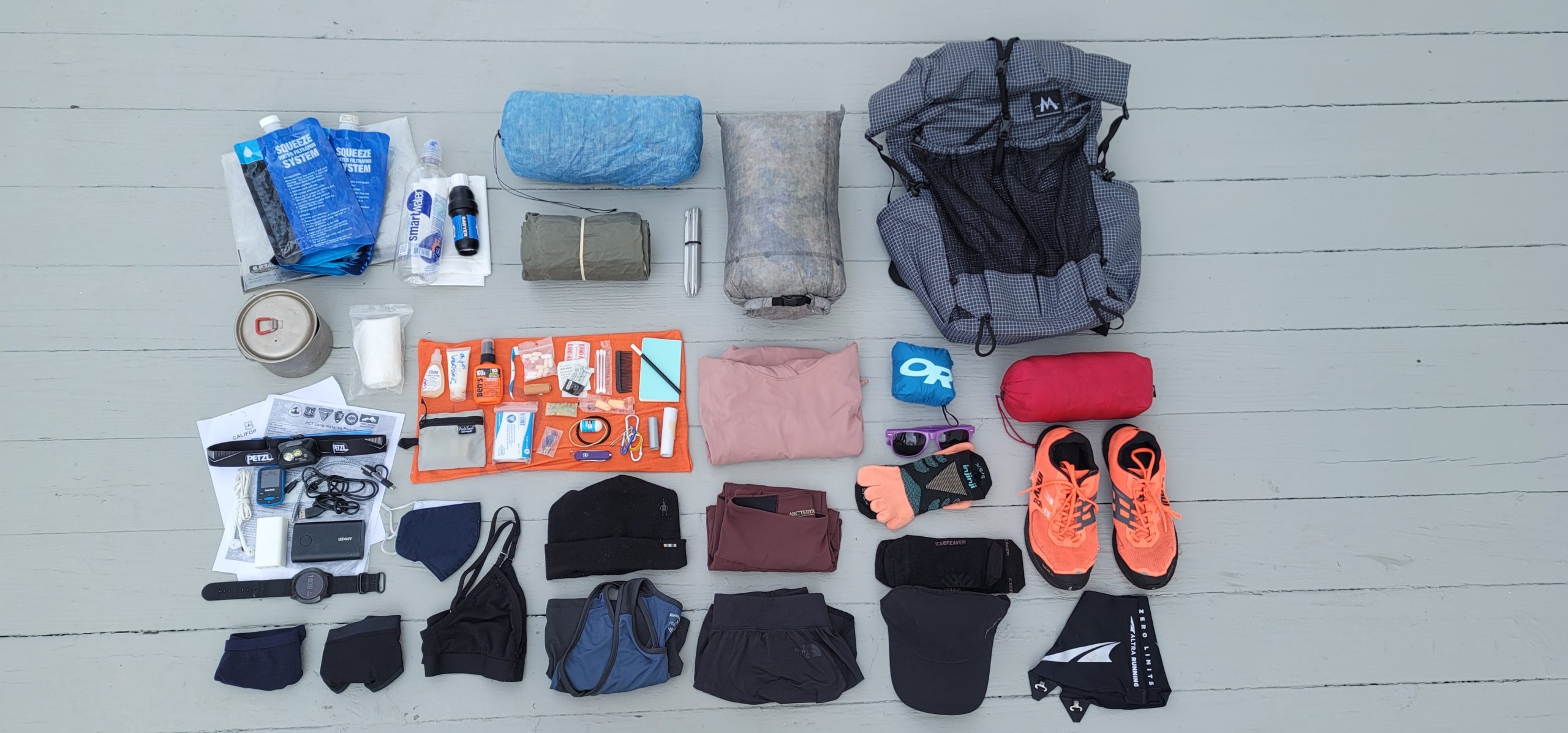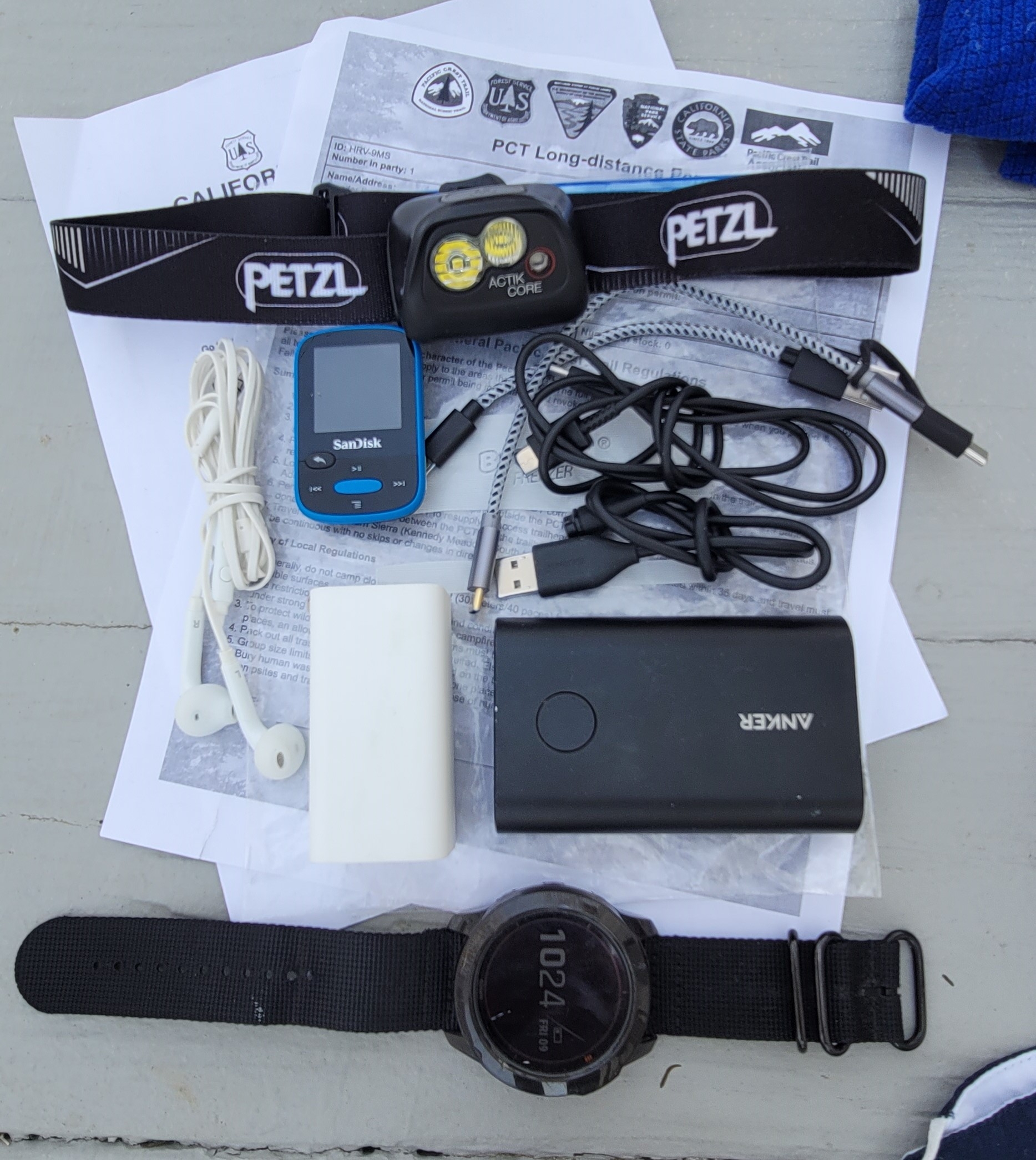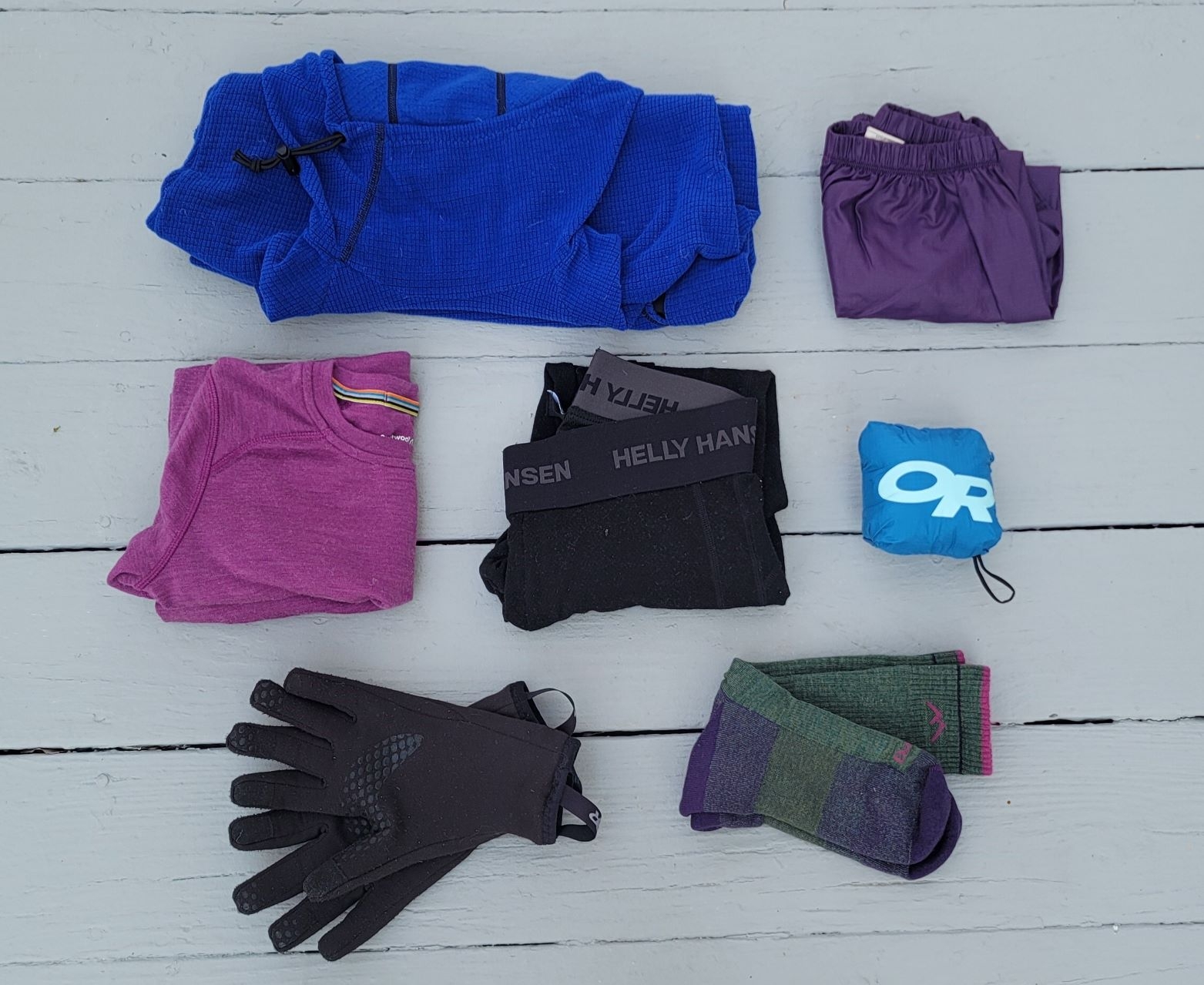2021 PCT Thru-Hiker Gear Breakdown
Gear breakdown – my favorite! I am a total gear junkie and have spent many hours researching each piece of gear in my pack; I am excited to share this with everyone. This is the gear that I need and find useful; that doesn’t mean it’s what will work best for you, so don’t think this is the best gear list, it’s just my gear list.
In preparing for the PCT I made some big changes to my hiking gear, most notably in my “Big 4” – backpack, tent, sleeping bag, and sleeping pad. I did this because that’s where you can save the most weight and then I don’t have to nickel and dime ounces later on. Most of the new gear was purchased from a second-hand or consignment shop since I love a good deal and I also love the planet. My goal in these changes was to have a base weight of around 10lbs. Base weight includes all the gear in your pack, minus consumable items like water, food, and fuel. It does not include what you wear on your body. I wanted to go lighter to decrease the stress put on my legs and feet and to be more comfortable during the day while hiking. So here it goes…
The Big 4
Backpack – Mountain Laurel Design Prophet 48L – This is a new one for me and my first foray into frameless packs. I had been using a framed pack, the Osprey Lumina 60, for previous long trips but I was ready to try something new and go lighter. If you want to read more about frameless packs, check out my post on Frameless Backpacks Fitting and Packing.
Tent – Another new item for me, the Zpacks Solplex, is the older version of the popular Plexamid. I had

been wary of trekking pole tents because they are harder to set up, but the lure of a 1lb tent was too great to pass up. I figured, if everyone else can do it, so can I. It turns out it’s not actually that difficult to set up, so I couldn’t be happier with my new tent. I use a mix of mini and regular length MSR Groundhog Tent Stakes because they are pretty light and work well in a variety of ground conditions. I am not using a groundsheet/footprint since I don’t feel it’s needed and I don’t want the extra weight.
Sleeping Pad – I decided to switch up my sleeping system because I get cold easily, especially at night. Most people don’t realize this, but cold ground is much more problematic than cold air. That’s where a sleeping pad comes in. I decided on the Therm-a-rest NeoAir XTherm Sleeping Pad because it’s one of the warmest pads out there (R-value 6.9) and weighs only 15oz.
Sleeping Bag – For my sleeping bag I knew I wanted a 0-degree bag since the temperature ratings are what you can survive at, not what’s comfortable. I also decided on a quit, which is basically a sleeping bag without a hood or a zipper. The idea of quilts came about because people realized that when you sleep on top of the insulation and compress it, it doesn’t keep you warm. A quilt is open to your sleeping pad on the bottom to help cut down on weight and let the pad insulate you from the ground. After many hours of research, I chose the 0 Degree Enlightened Equipment Enigma, because they make high-quality, ultralight quilts at some of the most competitive prices.
Read our review of the Enlightened Equipment Enigma.
Rain Protection – I am not a fan of pack covers because they always seem to leak. To keep my gear dry during rain or water crossings, I use a trash compactor bag. I line my pack with it and stuff everything inside. It works well, is easily fixable with duct tape, and can double as an emergency raincoat, groundsheet, and many other uses.
Food and Water
Filter – Sawyer Squeeze. Tried and true, lasts forever assuming you clean it regularly, and screws right on to the average plastic bottle. I would not recommend the micro or mini versions since they tend to have more issues. I also have a Katadyn BeFree that I love, love, love because of its high flow rate. It has a shorter lifespan of 1000 liters, the bottles are known to crack and break, and the larger opening won’t fit just any water bottle unlike the Sawyer.
Water Storage – I use the collapsible pouches that came with the Sawyer Squeeze, a Platypus 2L collapsible water bottle, and a Smartwater bottle with the sports cap that I use for drinking on the go and for adding drink mixes.
Stove – I use the MSR PocketRocket Deluxe Stove. It’s not as small as the regular PocketRocket, but it has better fuel regulation, wind protection, and a built-in ignition so I don’t have to fumble with any lighters.
Cookware – I have a do-it-all MSR Titan Kettle that I use for my cooking pot, bowl, and mug. It holds 750 mL, weighs 4.2oz.
Utensil – Vargo Titanium Ultralite Spork. I used to have a plastic spork but I broke it, so titanium is the way to go from now on. 0.5oz.
Food Storage – I use the odor-proof OPSack as my food bag. When hiking on the east coast I use my Ursack Major bear bag – it’s so easy to use and much lighter than a bear can. For the Sierra portion of the PCT, I will be using the BearVault BV500. It’s heavy and I hate it, but I love bears and I don’t have a choice anyway.
Electronics
For my electronics, I wanted to go light while still having enough juice. More importantly, I wanted a fast charging system that will charge everything quickly when in town, since I don’t usually like staying overnight in a hotel.
Power Bank – Anker Powercore+ 10050 – just enough juice for my electronics for probably 4 or 5 days with conservative phone usage.
Wall Charger – Elecjet 65W fast charger with 3 ports (2 x USB C ports, 1 x USB A port)
Cords – I have a series of 6″ cords to charge all my electronics – make sure they are fast charging.
Mp3 – Yes, I am bringing music. I don’t want to waste my phone battery since that is my navigation and my camera and those 2 functions are too critical to waste battery on something else. I got a little SanDisk Clip Sport which weighs only 1oz, plays songs for a tested 28h! I don’t normally listen to music, but it’s nice sometimes when you’re feeling lonely or down, to help you get up a big mountain, or to help me sleep at night. I use these with generic corded headphones since I don’t want to worry about another thing to charge.
Headlamp – When I am night hiking I like to have a bright, long-lasting headlamp with a variety of different light levels. I have the Petzl Actik Core – it’s rechargeable and has up to 450 lumens. When I am in camp I make sure to keep it on the red setting which is just enough to see and save the real light for hiking. I also have the much smaller and lighter Petzl e+LITE that I use as an emergency headlamp when rock climbing; it’s not rechargeable and not bright enough for regular usage so it will sit this trip out.
Watch – I got the Garmin Fenix 6X Pro Solar as my GPS navigation, tracker, running watch but I use it for so much more. I have never worn a watch my whole life, but I can’t take this thing off. It has many functions, but the pre-loaded GPS maps are indispensable for navigation in conjunction with apps on my phone. The only things I don’t like about it are 1. it’s big and heavy, and 2. there is no emergency SOS locator feature, which I really wish there was.
Worn Clothes
Top – For the desert, I’ll be wearing the Mountain Hardwear Crater Lake Long Sleeve Hoodie which has UPF 50+ to protect me from the desert sun. For cold sections of the trail, I will switch to the Smartwool Merino Wool 250 Top as my base layer.
Bottom – I usually prefer to hike, or do anything athletic, in leggings. I have a pair of the Arc’teryx Oriel Leggings that I use to climb, run and hike. I picked these ones because they’re super comfortable, durable, and light at 5.5oz. I also have The North Face Better Than Naked Split Shorts which are also super light, comfortable, and have a built-in liner.
Underwear – Icebreaker Women’s Siren Merino Wool Bra and underwear. Don’t let the idea of wool underwear scare you off, this isn’t your grandmother’s itchy wool sweater. Merino wool is soft, moisture-wicking, naturally odor-resistant, and super comfortable.
Socks – I have a few different types of socks I use depending on the weather. For when it’s hotter out I prefer the Icebreaker Run+ Ultralight Micro Socks. For cooler weather, I switch to Darn Tough Hiker Boot socks. I also have some Injinji toe socks that I use when I have been getting blisters on my toes.
Shoes – I have a variety of shoes I like to use, always minimalist trail runners because they are super light. I get whatever I can find on sale or lightly used second hand, usually around 30$. For the PCT I will be using my Inov-8 Trailroc 270 and a couple of Altra Lone Peak 4.5s.

Gaiters – Altra Trail Gaiters – 1 oz, super cheap, you won’t even notice they are there. They really help to keep rocks and debris out of your socks and shoes, which prevents blisters and injuries.
Hat – Arc’teryx Calvus Cap – lightweight, packable, and I got it for free from an event.
Poles – This is my first time using trekking poles. I still don’t really like to use them because I find them clunky and annoying, but I figure I’ll get used to that. I decided to start using poles for a number of reasons that I observed anecdotally and backed up by research: faster walking, better balance, decreased forces on your knees and ankles, and you can use lighter trekking pole tents. Drawbacks include having to deal with and carry another piece of gear and the 20% increase in calorie expenditure. I settled on the Black Diamond Trail Ergo Cork since I needed a telescoping pole to be compatible with my tent and I wanted aluminum shafts; I trip and fall a lot and assumed I would shatter carbon shafts. Also they’re a trail favorite.
Packed Clothing
Insulation – I love my Arc’teryx Cerium LT Hoody. It’s light (8.7 oz), packable, and keeps me very warm. I don’t usually hike in it except maybe a little in the morning or night, but it’s great at camp and to sleep in when night temperatures dip. Be aware, like most ultralight puffy jackets, the material is super thin and can snag and tear easily.
Fleece – I have an old Melanzana Micro Grid Hoodie that I love but it’s much heavier than I would like.
Base layers – As I mentioned before if it’s cold I will bring my Smartwool Merino Wool 250 Top and I can also add my Helly Hanson Lifa Pant if I need an extra warm layer to sleep in.
Rain Gear – For most of my trip I will be using my Outdoor Research Helium II Jacket. It’s very lightweight (5.5 oz) and packable, but it will wet through when hiking in constant rain. It’s great for most situations and acts as a windbreaker and extra layer. When there will be frequent, heavy rain as in Oregon and Washington, I will switch to the waterproof Arc’teryx Beta SL Hybrid Jacket. I also have wind / rain pants, Body Wrappers Ripstop Pants (3 oz), that work great to throw over shorts or as added wind and rain protection if needed, but like the Helium II, they’re not fully waterproof. Lastly, I also have the 1.5 oz REI Co-op Minimalist GTX Mittens, which I really appreciate when hiking all day in cold rain.
Gloves – Outdoor Research Waterproof Glove Liner, 2.5 oz, waterproof and warm.
Buff – I use my Norrona Microfiber Neck Buff as a neck gaiter for warmth, as a towel, and for many other purposes. A buff is a real multi-use tool.
Sleeping socks – Darn Tough Hiker No Show Light Cushion. I keep a clean pair of socks to sleep in. It’s so nice to have something clean and dry to put your feet in at night. I rotate these with my worn socks and wash in between.
Other Gear
Bug Net – For areas where the mosquitos are bad I will have the annoying but necessary – Even Naturals Mosquito Head Net.
 Ice Axe – In the snowy Sierras and if there will be snow on the mountains in the desert I have my CAMP Corsa Ice Axe. I will only be using it for emergency self arrests so I went with the lightest model available, only 7.2 oz.
Ice Axe – In the snowy Sierras and if there will be snow on the mountains in the desert I have my CAMP Corsa Ice Axe. I will only be using it for emergency self arrests so I went with the lightest model available, only 7.2 oz.
Crampons – Given my mid-April start date, I decided minimal microspikes, Kahtoola MICROspikes, are plenty of traction for me. If I were leaving earlier or for a high snow year, I would consider winter hiking boots and more robust crampons.
Miscellaneous
Toiletries: Toothbrush ( Colgate Wisp with replacements mailed in resupply boxes), chapstick (Chap Ice Mini Lip Balm), medications (Tylenol, Advil, Benadryl, etc.), bug spray, sunscreen (squeezed into a 0.5oz bottle), soap (concentrated in an eye dropper bottle), q-tips, hair tie, 1/2 plastic comb, earplugs, small toilet paper roll. 
First aid – Mini roll Leukotape (for blisters, chafe and to make bandaids), bacitracin packet, gauze.
Emergency – Emergency blanket, backup water treatment tablets.
Gear Repair – Mini duct tape roll, mini Gear Aid repair roll, mini sewing kit, swiss army knife, safety pin, mini carabiner.
Notebook and pen – Mini Moleskine notebook, mini pen.
Wallet – Cards, cash, PCT permit, fire permit.
Well, that’s my starting gear list. Stay tuned to see what works and what doesn’t!
Here’s my pack breakdown with all the weight of each item: https://packfire.com/packs/xryocesbkq
This website contains affiliate links, which means The Trek may receive a percentage of any product or service you purchase using the links in the articles or advertisements. The buyer pays the same price as they would otherwise, and your purchase helps to support The Trek's ongoing goal to serve you quality backpacking advice and information. Thanks for your support!
To learn more, please visit the About This Site page.

 ">
">


Comments 1
Good luck! I no longer backpack/hike, but, as retirement nears… maybe it is time to rebuild my gear stash!! Look forward to reading more on your PCT hike.